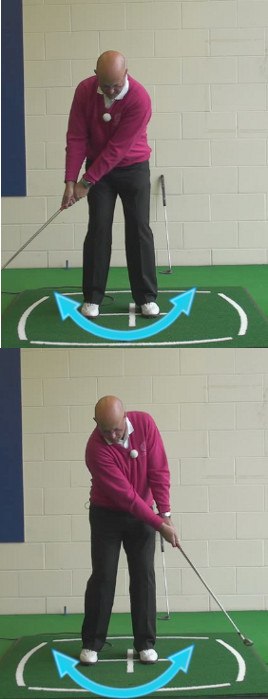There are generally two types of putting stroke that golfers employ.

These are a long, swinging stroke, or a short, popping stroke. Here is a description of both so that you can decide which type is yours.
The long, swinging stroke
This stroke has a regular tempo in its swing which means that the putter head travels backwards and forwards at an even rhythm. As a result, the length of this type of swing is very similar – the putter head swings back the same length as it does through. There is no tension in this stroke with the hands being loosely gripped around the handle of the club and the arms and wrists tend not to move throughout the putting swing as the putter is controlled by the shoulders.
The short, popping stroke
This stroke has a short back swing and a long follow through. The rhythm of the putter head is generally slow in the back swing and fast coming through the impact area to the finish which provides good acceleration through the ball in a 'pushing' type action.
The hands hold on to the grip of the putter solidly and there may be some hand and arm action through the putting swing.
Which is better?
Both types of putting stroke have advantages, however the long, swinging stroke provides the golfer with the best chance of being consistent in distance control and accuracy. This is because the bigger muscles of the body (shoulders) rather than the smaller muscles (hands and arms) are used to control the putter as it swings. As a result the swing will be less jerky and so more consistent.
Also the long, swinging stroke allows the golfer to control the distance of the putt more easily. This is done by swinging the putter backwards and forwards longer or shorter rather than hitting the ball harder or softer as is the case with a short popping stroke.
How do I practice a long, swinging putting stroke?
For this practice drill you need two head covers. Position the head covers approximately two feet apart and set up to take some putting practice swings directly in-between the two head covers. When practice swinging, focus on swinging the putter head in a good, balanced rhythm so that the putter head gently touches the two head covers at each end of the backswing and forward swing. This achieves a balanced length of swing.
Once you are comfortable with this rhythm and swing length, take a step back away from the head covers and replicate that swing motion with a golf ball in the way. Make sure to keep the same rhythm and the same swing length of the putter head. Over time this will become second nature and you will be able to alter your swing length to suit different lengths of putt.
Practise this drill to achieve a more repeatable putting stroke that makes it simple to control distance and hit accurate putts.






